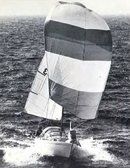Albin Viggen
Sailboat specifications
The Albin Viggen is a 23’4” (7.1m) cruising sailboat designed by Per Brohäll (Sweden). She was built between 1966 and 1977 by Albin Marine (Sweden).
Albin Viggen's main features
- Model
- Albin Viggen
- Hull type
- Monohull
- Category
- Cruising sailboat
- Sailboat builder
- Sailboat designer
- Country
- Sweden
- Construction
- Hull and deck: GRP (glass reinforced polyester)
- Number of hulls built
- About 1450
- First built hull
- 1966
- Last built hull
- 1977
- Appendages
- Keel : fin without bulb
- Helm
- Single tiller
- Rudder
- Single rudder on skeg
- Unsinkable
- No
- Trailerable
- Yes
- Standard public price ex. VAT (indicative only)
- N/A €
Albin Viggen's main dimensions
- Hull length
- 23’ 4”7.1 m
- Waterline length
- 19’ 8”6 m
- Beam (width)
- 7’ 4”2.24 m
- Draft
- 3’ 7”1.11 m
- Light displacement (MLC)
- 3086 lb1400 kg
- Ballast weight
- 1323 lb600 kg
Albin Viggen's rig and sails
- Upwind sail area
- 320 ft²29.7 m²
- Downwind sail area
- 573 ft²53.2 m²
- Mainsail area
- 110 ft²10.2 m²
- Genoa area
- 210 ft²19.5 m²
- Jib area
- 108 ft²10 m²
- Symmetric spinnaker area
- 463 ft²43 m²
- Rigging type
- Sloop Marconi masthead
- Mast configuration
- Deck stepped mast
- Rotating spars
- No
- Number of levels of spreaders
- 1
- Spreaders angle
- 0 °
- Spars construction
- Aluminum spars
- Standing rigging
- 1x19 strand wire continuous
Albin Viggen's performances
- IOR ratingiIOR, or International Offshore Rule, was a measurement rule system used internationally for ocean racing. It allows boats of different sizes and designs to race each other fairly. Therefore, by comparing these values, we can have an indication of the relative speed of 2 boats.
- 19.6
- Upwind sail area to displacementiThe ratio sail area to displacement is obtained by dividing the sail area by the boat's displaced volume to the power two-thirds.
The ratio sail area to displacement can be used to compare the relative sail plan of different sailboats no matter what their size.
Upwind: under 18 the ratio indicates a cruise oriented sailboat with limited performances especially in light wind, while over 25 it indicates a fast sailboat. - 255 ft²/T23.73 m²/T
- Downwind sail area to displacementiThe ratio sail area to displacement is obtained by dividing the sail area by the boat's displaced volume to the power two-thirds.
The ratio sail area to displacement can be used to compare the relative sail plan of different sailboats no matter what their size. - 458 ft²/T42.51 m²/T
- Displacement-length ratio (DLR)iThe Displacement Length Ratio (DLR) is a figure that points out the boat's weight compared to its waterline length. The DLR is obtained by dividing the boat's displacement in tons by the cube of one one-hundredth of the waterline length (in feet).
The DLR can be used to compare the relative mass of different sailboats no matter what their length:
a DLR less than 180 is indicative of a really light sailboat (race boat made for planning), while a DLR greater than 300 is indicative of a heavy cruising sailboat. - 184
- Ballast ratioiThe Ballast ratio is an indicator of stability; it is obtained by dividing the boat's displacement by the mass of the ballast. Since the stability depends also of the hull shapes and the position of the center of gravity, only the boats with similar ballast arrangements and hull shapes should be compared.
The higher the ballast ratio is, the greater is the stability. - 43 %
- Critical hull speediAs a ship moves in the water, it creates standing waves that oppose its movement. This effect increases dramatically the resistance when the boat reaches a speed-length ratio (speed-length ratio is the ratio between the speed in knots and the square root of the waterline length in feet) of about 1.2 (corresponding to a Froude Number of 0.35) . This very sharp rise in resistance, between speed-length ratio of 1.2 to 1.5, is insurmountable for heavy sailboats and so becomes an apparent barrier. This leads to the concept of "hull speed".
The hull speed is obtained by multiplying the square root of the waterline length (in feet) by 1.34. - 5.95 knots
Albin Viggen's auxiliary engine
- Engine(s)
- No engine
Albin Viggen's accommodations and layout
- Cockpit
- Closed aft cockpit
- Berth(s)
- 4
- Freshwater tank capacity
- 11.9 gal45 liters



Albin Marine Albin Viggen sailplan - - 2/7
Picture extracted from the commercial documentation © Albin Marine
Picture extracted from the commercial documentation © Albin Marine


Albin Marine Albin Viggen layout - - 3/7
Picture extracted from the commercial documentation © Albin Marine
Picture extracted from the commercial documentation © Albin Marine


Albin Marine Albin Viggen sailing - - 4/7
Picture extracted from the commercial documentation © Albin Marine
Picture extracted from the commercial documentation © Albin Marine


Albin Marine Albin Viggen sailing - - 5/7
Picture extracted from the commercial documentation © Albin Marine
Picture extracted from the commercial documentation © Albin Marine


Albin Marine Albin Viggen sailing - - 6/7
Picture extracted from the commercial documentation © Albin Marine
Picture extracted from the commercial documentation © Albin Marine


Albin Marine Albin Viggen interior and accommodations - - 7/7
Picture extracted from the commercial documentation © Albin Marine
Picture extracted from the commercial documentation © Albin Marine
Similar sailboats that may interest you:
Sailboats
First built hull
Hull length
1982
23’ 7”7.2 m
1982
23’ 7”7.2 m
1965
27’ 1”8.25 m
1985
22’ 7”6.9 m
1961
22’ 7”6.9 m
1982
24’ 7”7.5 m
2005
24’ 6”7.47 m
1969
25’ 11”7.9 m
1978
19’ 8”6 m
1970
21’ 8”6.6 m
1973
20’ 4”6.2 m
1974
20’ 4”6.2 m
1977
23’ 7”7.2 m
1978
21’ 6”6.55 m
1979
24’ 11”7.6 m